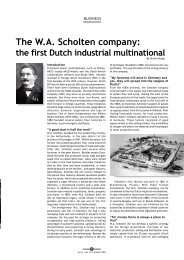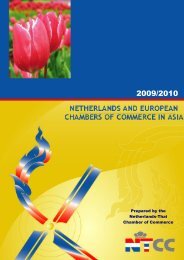August 2005 - Association of Dutch Businessmen
August 2005 - Association of Dutch Businessmen
August 2005 - Association of Dutch Businessmen
Create successful ePaper yourself
Turn your PDF publications into a flip-book with our unique Google optimized e-Paper software.
POP AND DROP A QUESTION<br />
Bring intelligence into the<br />
Business<br />
Intelligence is all<br />
about converting<br />
the endless<br />
stream <strong>of</strong> data<br />
produced by doing<br />
business into<br />
information that<br />
can be used to<br />
make better<br />
business<br />
decisions.<br />
This conversion<br />
process consists <strong>of</strong><br />
gathering,<br />
transforming,<br />
storing and<br />
analysing that<br />
data and last but<br />
not least<br />
providing access<br />
to the outcome<br />
allowing factbased<br />
decision<br />
making.<br />
Question to Jeroen<br />
Dijkxhoorn, Manager<br />
Technology strategy<br />
group Asia Pacific at<br />
SAS institute.<br />
What is Business Intelligence?<br />
And what is the status <strong>of</strong> BI in<br />
Asia Pacific?<br />
Answer<br />
There is a deceptive nature<br />
to the definition <strong>of</strong> Business<br />
Intelligence, especially for the<br />
<strong>Dutch</strong>. This is caused by the<br />
word ‘Intelligence’. Intelligence<br />
in this case is not referring to human cognitive<br />
capabilities, as the <strong>Dutch</strong> word ‘Intelligentie’ is,<br />
but to information and the process <strong>of</strong> gathering<br />
information.<br />
Therefore Business Intelligence is all about<br />
converting the endless stream <strong>of</strong> data produced<br />
by doing business into information that can be used<br />
to make better business decisions. This conversion<br />
process consists <strong>of</strong> gathering, transforming, storing<br />
and analysing that data and last but not least<br />
providing access to the outcome allowing factbased<br />
decision making.<br />
Nevertheless, the ambiguity in the term<br />
‘Intelligence’ is always nice to use, when talking<br />
to executives, claiming that ‘It is time to bring<br />
intelligence into the boardroom!’<br />
Over the years BI has also<br />
become synonym for the<br />
information technology systems<br />
and applications providing<br />
these capabilities. And as for<br />
all definitions in the Information<br />
Technology space is prone<br />
to slight changes depending<br />
on whoever (or better: what<br />
company) is using the term.<br />
Typical applications <strong>of</strong> BI<br />
deal with three main categories<br />
<strong>of</strong> Business: Suppliers, Internal<br />
Organisation and Customers. The<br />
customer intelligence category<br />
is the biggest as the information<br />
derived is directly influencing<br />
the competitiveness, ability to increase revenue<br />
and improve pr<strong>of</strong>itability <strong>of</strong> an organisation.<br />
Understanding the customer demographics,<br />
analysing customer behaviour, predicting customer<br />
demand and segmenting customers based on<br />
pr<strong>of</strong>itability, likelihood to accept <strong>of</strong>fers and<br />
likelihood to move to the competition are some<br />
examples <strong>of</strong> BI objectives in this area.<br />
The supplier side, although small in market<br />
size, is able to generate huge cost savings for<br />
companies. Imagine the number <strong>of</strong> suppliers<br />
<strong>of</strong> a globally operating company and the total<br />
spend across all those suppliers. Having a<br />
clear understanding <strong>of</strong> the total spend and the<br />
inter-relationships <strong>of</strong> those suppliers, allows<br />
for consolidation <strong>of</strong> purchasing contracts and<br />
negotiating better rates. On the qualitative side<br />
and the strive for business continuity it also<br />
allows better management <strong>of</strong> supplier efficiency<br />
and assessing credit worthiness.<br />
The internal organisation category is the<br />
most diverse <strong>of</strong> all. Applications range from<br />
consolidation, budgeting and planning in the<br />
financial area to resource optimization in the<br />
internal IT organisation. Besides generic across<br />
industry applications, this category contains a<br />
lot <strong>of</strong> industry specific applications as well.<br />
In the Banking industry, for instance, Risk<br />
Management is a very important area due to direct<br />
relationship to the cost structure <strong>of</strong> the bank,<br />
competitiveness in credit markets and the evergrowing<br />
regulatory pressures. Revenue assurance<br />
is another example, in this case specific for<br />
the Telecommunications industry. The average<br />
18<br />
Vol.15 • No. 6 • July/<strong>August</strong> <strong>2005</strong>
















